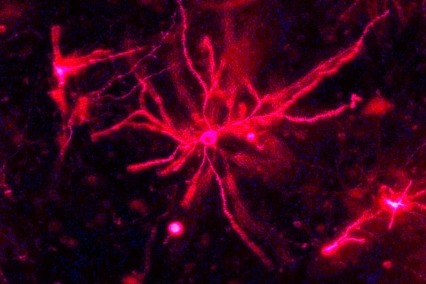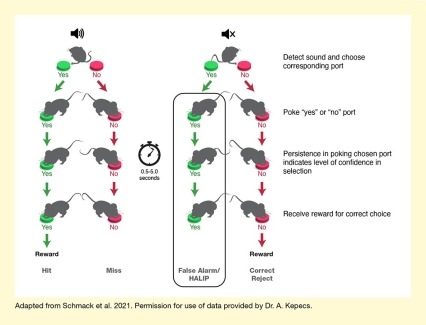This study reported that:

- A behavioral testing model was able to measure hallucination-like perceptions in mice and was consistent with similar assessments in humans.
- Hallucination-like perceptions in mice were associated with elevated dopamine levels in the striatum.
- Blocking dopamine with haloperidol reversed these hallucination-like perceptions in mice.
Hallucinations—false perceptions that are experienced with the same confidence as true perceptions—are a defining symptom of psychosis but can also occur during episodes of drug use. Because hallucinations are a subjective phenomenon that relies on self-report, they cannot be directly studied in animals. Studies have indicated that hallucinations are associated with elevated dopamine levels in the brain, and dopamine receptor blockers can reduce psychotic symptoms in patients. The circuits and mechanisms underlying this association, however, have not been studied due to a lack of animal models.
In a recent NIDA-funded study, Dr. Katharina Schmack and colleagues from the Cold Spring Harbor Laboratory and Washington University in St. Louis presented a new mouse model of hallucination and demonstrated that increased dopamine levels in a part of the brain’s striatum were associated with hallucination-like perceptions (HALIPs) in the animals. This novel model may offer researchers a new tool to better understand how hallucinations in humans develop and how they might be treated.
Mice Can “Report” HALIPs
To identify HALIPs, the researchers intermittently exposed mice to specific sound signals at different volumes that were embedded in a background of white noise. The mice were then trained to “report” whether or not they heard the sound. When they perceived the sound, they poked their nose into a “yes” choice port; if they did not hear the signal, they poked their nose into a “no” choice port (see Figure). When a mouse nosed the correct port—that is, selected the “yes” port when there was a signal or the “no” port when there was no signal—it was rewarded with water after a variable, unpredictable amount of time. The investigators also assessed how certain the mice were that their responses were correct, by recording how long the animals would continue to poke the port in anticipation of their water rewards. The more “confident” the animals were in their response, the longer they were willing to search for their rewards after choosing a port.
However, in about 16 percent of tests without a signal, the animals indicated hearing the sound by poking the “yes” port, even though no signal was presented; this was labeled a “false alarm.” Through various tests, the team determined that these false alarms were unlikely to result from the animals not paying attention, preferring one specific port, being tired or not thirsty, or other potential explanations. Therefore, they concluded that these false alarms indeed represented HALIPs.
To test this assumption, the researchers exposed the mice to two interventions that can induce hallucinations in humans—greater expectations of perceiving a signal and treatment with the drug ketamine. To increase signal expectation, the researchers increased the proportion of tests in which the signal sound was given; as a result, the animals were more likely to expect to hear the sound. This increase in signal expectation was associated with a significant increase in the number of false alarms, and particularly high-confidence false alarms (i.e., HALIPs). Ketamine treatment also led to increased rates of false alarms and high-confidence false alarms.
Humans Also Experience HALIPs
To verify that HALIPs in mice are a meaningful model of related processes in humans, the researchers conducted similar experiments with 220 people. Participants were asked to press “yes” or “no” buttons depending on whether they heard a sound over a white-noise background and to rate how confident they were about their response. In about 7 percent of tests, the participants responded with false alarms, often with high confidence. Both the total false alarm rate and the high-confidence false alarm rate were higher in participants who reported that they were prone to hallucinations.
Computer simulations based on the mouse and human study data revealed that prior experience affected how often individuals recorded false alarms in the trials. Both mice and humans tended to repeat their previous selection, particularly after making a low-confidence correct choice. According to this “belief-updating model,” HALIPs occur when expectations based on prior experiences (e.g., hearing the signal or receiving the reward) outweigh the current sensory information.
HALIPs Are Associated with Elevated Dopamine Levels in the Striatum
Because high dopamine levels have long been suspected to be associated with hallucinations, Dr. Schmack and colleagues also examined whether elevated dopamine levels in the striatum—a brain region implicated in processing of rewards (ventral striatum) and perceptions (tail of the striatum)—predicted HALIPs in their mouse model. The analyses found that in tests without a signal tone, dopamine levels in both striatal regions were higher before a false alarm than before a correct no-signal choice and were also higher before high-confidence than low-confidence false alarms. This suggests that dopamine levels in different regions of the striatum influence both perceptual and reward-based expectations.
Dopamine’s role in HALIPs was further confirmed when experimentally induced activation of dopamine in the tail of the striatum increased the rate of total false alarms and high-confidence false alarms. Conversely, treatment with the antipsychotic medication haloperidol to block dopamine receptors and thus prevent dopamine’s actions reversed dopamine-induced increases in false alarms and high-confidence false alarms.
The researchers concluded that their approach for inducing HALIPs in mice can indeed serve as a model for hallucinations in humans. Their findings also support the hypothesis that hallucinations occur when individuals’ reactions are governed more by what they expect to happen rather than what their senses tell them, due to elevated dopamine levels particularly in the tail of the striatum. They hope that this model will allow scientists to identify the specific brain circuits underlying hallucinations, which is a first step for developing new treatments for psychotic disorders.
This research was supported by NIDA grant DA038209.
- Text Description of Figure
-
The figure shows graphically indicates the experimental design to identify HALIPS in mice. The left panel represents trials in which a sound is given for the mice to respond to, as indicated by the loudspeaker-and-soundwave symbol at the top. The right panel represents trials without a sound as indicated by the loudspeaker symbol with an X at the top. In each panel, there are four rows of gray mice with two buttons that indicate the “yes” and “no” ports. Green buttons on the left of each panel represent the “yes” port that mice poke to report hearing a sound, and red buttons on the right represent “no” ports that the mice poke to report not hearing a sound. A stopwatch symbol in the middle of the figure indicates the persistence with which the mice poke the chosen port. Mice that correctly poke the “yes” button when hearing a sound or correctly poke the “no” button when not hearing a sound receive a reward. A black frame indicates mice that persistently poke the “yes” button in the absence of a sound; it indicates that this scenario of a “false alarm” is thought to be indicative of HALIPS.
Source:
- Schmack K, Bosc M, Ott T, Sturgill JF, Kepecs A. Striatal dopamine mediates hallucination-like perception in mice. Science. 2021;372:eabf4740. doi: 10.1126/science.abf4740.
